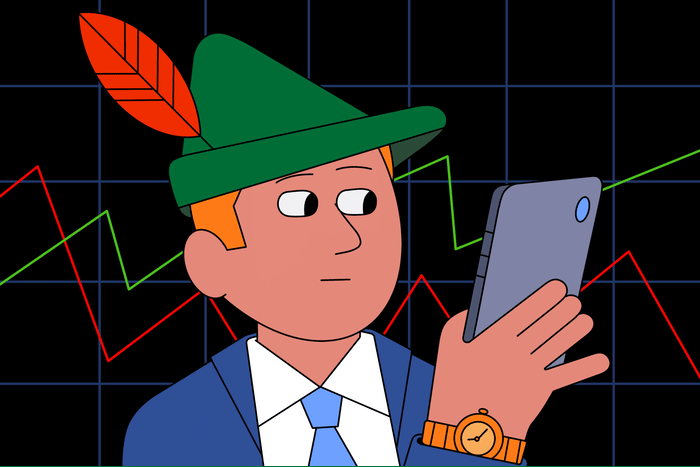The Robinhood IPO Is Coming Soon. Steer Clear.

There will be no velvet rope at Robinhood Markets’ big debut on Thursday. The company is offering up to a third of its shares in its initial public offering to the Average Joes who use its app, instead of the Wall Street suits who usually get first dibs. The wisdom of those crowds may validate the $35 billion valuation that the company projected in a prospectus. But its numbers don’t.
Make no mistake, Robinhood is a truly transformational company. Founders Vlad Tenev and Baiju Bhatt took a simple premise—zero commissions—and upended the brokerage industry. Its success forced the other major brokers to eliminate commissions and opened the door to millions of new investors who had never traded before. The company estimates that nearly half of all new brokerage accounts in the U.S. between 2016 and 2021 were opened at Robinhood. That’s even more impressive given that 2020 was a record year for new accounts in the U.S., and 2021 is shaping up to be even better.
Robinhood is on track to generate enough revenue this year to justify a valuation of $35 billion in theory. It reported revenue of $522 million in the first quarter, and the company estimated that it pulled in between $546 million and $574 million in the second.
Thomas Mason, an analyst at S&P Global Market Intelligence, notes that when TD Ameritrade was a fast-growing broker in 1999, it traded at more than 26 times total net revenue. That would value Robinhood, with $1.35 billion in total net revenue for the four quarters ended March 31, at $35 billion.
Robinhood’s problem, however, is the quality and sustainability of its revenue. At least three quarters of it comes from routing customers’ trades to trading firms that execute the trades and profit off the spread between the bid and the ask, a practice called payment for order flow. During trading frenzies, payment for order flow rises. But when trading slumps, payment for order flow slumps, too. That’s one reason most other brokers rely on other revenue streams for the majority of their revenue. Payment for order flow is also in the crosshairs of regulators, with Securities and Exchange Commission Chairman Gary Gensler raising concerns about it in recent weeks.
Robinhood by the Numbers
The online trading platform released second-quarter financial estimates ahead of its initial public offering next week.
| Key Data | |
|---|---|
| Funded accounts | 22.5 Million |
| Revenue | $546 Million to $574 Million |
| Net income | -$487 Million to -$537 Million |
| Assets under custody | $102 Billion |
Note: The numbers in the filing are preliminary and subject to change.
Robinhood is also highly dependent on cryptocurrency trading, another area now getting a close review by the SEC. Trading in Dogecoin, the joke cryptocurrency favored by Elon Musk, made up about 6% of the company’s revenue in the first quarter.
Thomas Peterffy, the chairman of Interactive Brokers, which focuses on more experienced traders, has been impressed by Robinhood and its ability to introduce new people into the market. “I’m a little bit talking my own book, because we get five to 10 customers from Robinhood every day,” he says. But he wouldn’t invest in the IPO. “I like to understand the profitability of a business,” he said. “But there is not a simple way to project Robinhood’s profits going forward, or even understand it going backward.”
Robinhood could pivot to other business models—its goal is to branch out into lending and payments. But the company’s forays into new areas have not gone well so far. In fact, they have sometimes flopped in spectacular ways. In 2018, it had to withdraw its plan to offer checking and savings accounts after being called out for misleading marketing and a lack of insurance, and later backtracked on plans to offer trading in the U.K. and to obtain a bank charter. Barron’s has followed Robinhood’s twists and turns, including a cover story last August.
The company says in its prospectus that its customers “already trust us with their hard-earned cash and assets,” so they will likely trust it to take care of their other needs as they grow their wealth. The company did not reveal just how much of that hard-earned money the typical customer has put in her account, but the Financial Industry Regulatory Authority said in an enforcement letter that the median Robinhood customer had $240 in her account as of February.
Many investors seem to consider Robinhood their “play-money account,” says Hugh Tallents, senior partner at management consultancy cg42, which surveyed more than 1,000 account-holders at various brokers about their habits this year. To justify the valuation, “customers will have to change their financial behavior to integrate a lot of their financial life with a company that has been mired in scandal for a long time. I just don’t see that being likely,” Tallents says.
Nearly every financial technology company is now focused on cross-selling customers on multiple services. Square (SQ), Stash, PayPal (PYPL), SoFi Technologies (SOFI) and more all want a bigger piece of your financial life. And some are able to make better first impressions. SoFi is known for refinancing student loans, for instance.
Getting from a student loan to a mortgage is “a bit of a layup,” Tallents says. “It’s far harder to envisage a world where people take a quite basic tool, which Robinhood is by design, and put a lot of their debt-based products or their savings accounts and integrate those things together.”
Write to Avi Salzman at [email protected]




